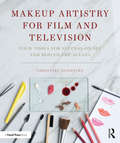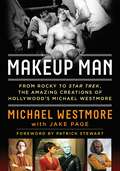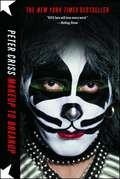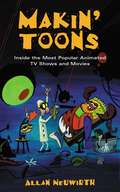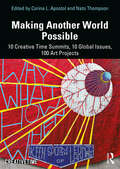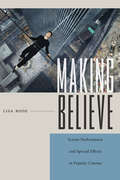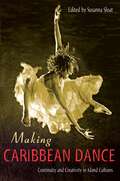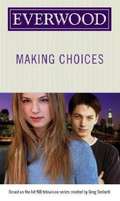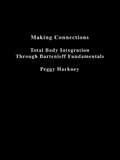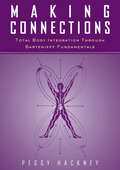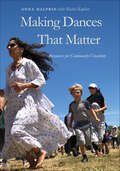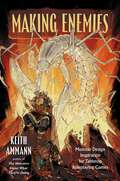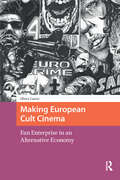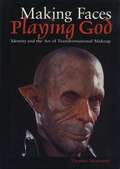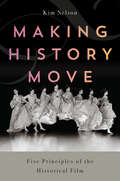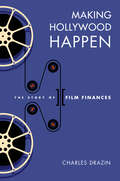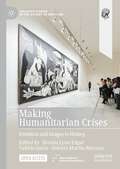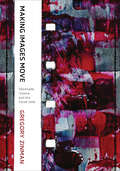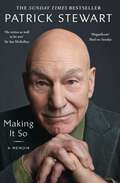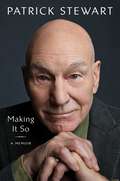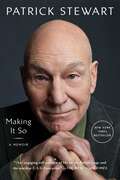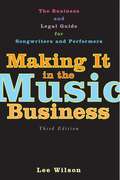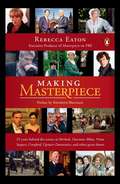- Table View
- List View
Makeup Artistry for Film and Television: Your Tools for Success On-Set and Behind-the-Scenes
by Christine SciortinoIn this comprehensive handbook author, makeup artist, and educator Christine Sciortino offers a detailed introduction to the conceptual foundations, techniques, and on-set practices of the makeup design process, going beyond technique-centered makeup education to provide an in-depth look at the workings of the film and television world. Through personal stories, interviews, demonstrations, and insights from Sciortino and her colleagues, this book explores the business of makeup artistry, including tailoring a resume, building a kit, self-marketing, breaking down a script, researching and creating makeup looks, working as part of a production team, and different ways to get paid. It further delves into on-set procedures and theory such as anatomy, skin science, color theory, and lighting design. With high-quality step-by-step photo tutorials, this book will help readers to learn and hone techniques for beauty makeup, character makeup, and light special effects including aging and dirtying, grooming, bruises and prosthetics, tattoos, and more. An emphasis is placed on working with actors of all ages, skin tones, and gender identities. This approachable and engaging blend of practical techniques and professional practice is ideal for both introductory-level and established artists. An online resource also offers downloadable templates and sample paperwork for on-set use and practice.
Makeup Man: From Rocky to Star Trek The Amazing Creations of Hollywood's Michael Westmore
by Jake Page Michael WestmoreHeadline: A peak behind the Hollywood mask by one of its foremost makeup artistsIn Hollywood&’s heyday, almost every major studio had a Westmore heading up the makeup department. Since 1917, there has never been a time when Westmores weren&’t shaping the visages of stardom. For their century-long dedication to the art of makeup, the Westmores were honored with a star on the Hollywood Walk of Fame in 2008. In this lively memoir, Michael Westmore not only regales us with tales of Hollywood&’s golden age, but also from his own career where he notably transformed Sylvester Stallone into Rocky Balboa and Robert DiNiro into Jake LaMotta, among many other makeup miracles. Westmore&’s talent as a makeup artist first became apparent when he created impenetrable disguises for Kirk Douglas, Tony Curtis, Burt Lancaster, Robert Mitchum, and Frank Sinatra for the 1963 film The List of Adrian Messenger. He later went on to become the preferred makeup man for Bobby Darin and Elizabeth Taylor, and worked on such movies and TV shows as The Munsters, Rosemary&’s Baby, Eleanor and Franklin, New York, New York, 2010: A Space Odyssey, and Mask, for which he won an academy award. The next phase of his career was to create hundreds of alien characters for over 600 episodes of Star Trek in all its iterations, from The Next Generation to Enterprise.Replete with anecdotes about Hollywood and its stars, from Bette Davis&’s preference for being made-up in the nude to Shelley Winters&’s habit of nipping from a &“little bottle&” while on the set, Makeup Man will satisfy any Hollywood&’s fan&’s appetite for gossip or a behind-the-scenes look at how tinsel town&’s most iconic film characters were created.Academy Award-winning Michael Westmore has been making up the stars for over fifty years. He frequently appears on the SyFy channel show Face Off with his daughter McKenzie Westmore.
Makeup to Breakup: My Life In and Out of Kiss
by Peter CrissLEGENDARY founding KISS drummer Peter “Catman” Criss has lived an incredible life in music, from the streets of Brooklyn to the social clubs of New York City to the ultimate heights of rock ’n’ roll success and excess. KISS formed in 1973 and broke new ground with their elaborate makeup, live theatrics, and powerful sound. The band emerged as one of the most iconic hard rock acts in music history. Peter Criss, the Catman, was the heartbeat of the group. From an elevated perch on his pyrotechnic drum riser, he had a unique vantage point on the greatest rock show of all time, with the KISS Army looking back at him night after night. Peter Criscuola had come a long way from the homemade drum set he pounded on nonstop as a kid growing up in Brooklyn in the fifties. He endured lean years, street violence, and the rollercoaster music scene of the sixties, but he always knew he’d make it. Makeup to Breakup is Peter Criss’s eye-opening journey from the pledge to his ma that he’d one day play Madison Square Garden to doing just that. He conquered the rock world—composing and singing his band’s all-time biggest hit, “Beth” (1976)—but he also faced the perils of stardom and his own mortality, including drug abuse, treatment in 1982, near-suicides, two broken marriages, and a hard-won battle with breast cancer. Criss opens up with a level of honesty and emotion previously unseen in any musician’s memoir. Makeup to Breakup is the definitive and heartfelt account of one of rock’s most iconic figures, and the importance of faith and family. Rock ’n’ roll has been chronicled many times, but never quite like this.
Makin' Toons: Inside the Most Popular Animated TV Shows and Movies
by Allan NeuwirthFrom the first drawing board sketch to wriggling TV character, Makin' Toons illustrates the thrills and challenges of making animated cartoon movies as told by the industry's most successful creators. Cartoon lovers everywhere will be treated to 47 personal interviews with animation artists and industry leaders ranging from Shrek director Andrew Adamson to Rugrats producer Gabor Csupo. These and dozens of other fascinating firsthand accounts chronicle the behind-the-scene antics and commercial dynamics behind such blockbusters as The Simpsons, South Park, Beauty and the Beast, and Dragon Tales, to name just a few. Author Allan Neuwirth-an accomplished animation artist and writer himself-spices the book with insightful comments, hilarious anecdotes, and a true "toon artist's" sense of humor. He also includes 75 never-before-published concept drawings, character designs, storyboards, and much more.Allworth Press, an imprint of Skyhorse Publishing, publishes a broad range of books on the visual and performing arts, with emphasis on the business of art. Our titles cover subjects such as graphic design, theater, branding, fine art, photography, interior design, writing, acting, film, how to start careers, business and legal forms, business practices, and more. While we don't aspire to publish a New York Times bestseller or a national bestseller, we are deeply committed to quality books that help creative professionals succeed and thrive. We often publish in areas overlooked by other publishers and welcome the author whose expertise can help our audience of readers.
Making Another World Possible: 10 Creative Time Summits, 10 Global Issues, 100 Art Projects
by Nato Thompson Corina L. ApostolMaking Another World Possible offers a broad look at an array of socially engaged cultural practices that have become increasingly visible in the past decade, across diverse fields such as visual art, performance, theater, activism, architecture, urban planning, pedagogy, and ecology. Part I of the book introduces the reader to the field of socially engaged art and cultural practice, spanning the past ten years of dynamism and development. Part II presents a visually striking summary of key events from 1945 to the present, offering an expansive view of socially engaged art throughout history, and Part III offers an overview of the current state of the field, elucidating some of the key issues facing practitioners and communities. Finally, Part IV identifies ten global issues and, in turn, documents 100 key artistic projects from around the world to illustrate the various critical, aesthetic and political modes in which artists, cultural workers, and communities are responding to these issues from their specific local contexts. This is a much needed and timely archive that broadens and deepens the conversation on socially engaged art and culture. It includes commissioned essays from noted critics, practitioners, and theorists in the field, as well as key examples that allow insights into methodologies, contextualize the conditions of sites, and broaden the range of what constitutes an engaged culture. Of interest to a wide range of readers, from practitioners and scholars of performance to curators and historians, Making Another World Possible offers both breadth and depth, spanning history and individual works, to offer a unique insight into the field of socially engaged art.
Making Believe: Screen Performance and Special Effects in Popular Cinema
by Lisa BodeIn the past twenty years, we have seen the rise of digital effects cinema in which the human performer is entangled with animation, collaged with other performers, or inserted into perilous or fantastic situations and scenery. Making Believe sheds new light on these developments by historicizing screen performance within the context of visual and special effects cinema and technological change in Hollywood filmmaking, through the silent, early sound, and current digital eras. Making Believe incorporates North American film reviews and editorials, actor and crew interviews, trade and fan magazine commentary, actor training manuals, and film production publicity materials to discuss the shifts in screen acting practice and philosophy around transfiguring makeup, doubles, motion capture, and acting to absent places or characters. Along the way it considers how performers and visual and special effects crew work together, and struggle with the industry, critics, and each other to define the aesthetic value of their work, in an industrial system of technological reproduction. Bode opens our eyes to the performing illusions we love and the tensions we experience in wanting to believe in spite of our knowledge that it is all make believe in the end.
Making Caribbean Dance: Continuity and Creativity in Island Cultures
by Susanna SloatExplore the vibrant and varied dance traditions of the Caribbean islandsCaribbean dance is a broad category that can include everything from nightclubs to sacred ritual. Making Caribbean Dance connects the dance of the islands with their rich multicultural histories and complex identities. Delving deep into the many forms of ritual, social, carnival, staged, experimental, and performance dance, the book explores some of the most mysterious and beloved, as well as rare and little-known, dance traditions of the region.From the evolution of Indian dance in Trinidad to the barely known rituals of los misterios in the Dominican Republic, this volume looks closely at the vibrant and varied movement vocabulary of the islands. With distinctive and highly illuminating chapters on such topics as experimental dance makers in Puerto Rico, the government's use of dance in shaping national identity in Barbados, the role of calypso and soca in linking Anglophone islands, and the invented dances of dance-hall kings and queens of Jamaica, this volume is an evocative and enlightening exploration of some of the world’s most dynamic dance cultures.
Making Choices (Everwood #4)
by Laura J. Burns Melinda MetzBased on the popular WB television show "Everwood". Ephraim Brown learns just how hard it is to maintain a relationship with a girl who's many miles away.
Making Cinelandia: American Films and Mexican Film Culture before the Golden Age
by Laura Isabel SernaIn the 1920s, as American films came to dominate Mexico's cinemas, many of its cultural and political elites feared that this "Yanqui invasion" would turn Mexico into a cultural vassal of the United States. In Making Cinelandia, Laura Isabel Serna contends that Hollywood films were not simply tools of cultural imperialism. Instead, they offered Mexicans on both sides of the border an imaginative and crucial means of participating in global modernity, even as these films and their producers and distributors frequently displayed anti-Mexican bias. Before the Golden Age of Mexican cinema, Mexican audiences used their encounters with American films to construct a national film culture. Drawing on extensive archival research, Serna explores the popular experience of cinemagoing from the perspective of exhibitors, cinema workers, journalists, censors, and fans, showing how Mexican audiences actively engaged with American films to identify more deeply with Mexico.
Making Connections: Total Body Integration Through Bartenieff Fundamentals
by Peggy HackneyHuman movement influences an individual's perceptions and ability to interact with the world. Through exercises, illustrations, and detailed anatomical drawings, this remarkable book guides the reader toward total body integration. An experimental approach to movement fundamentals involving the patterning of connections in the body according to principles of efficient movement, the process of total body integration encourages personal expression and full psychological involvement.
Making Connections: Total Body Integration Through Bartenieff Fundamentals
by Peggy HackneyThis book explores how we go about creating the connections within us that allow us to become fully embodied human beings in the world. It provides some very personal memories of Irmgard Bartenieff and the development of her approach to Fundamentals.
Making Dances That Matter: Resources for Community Creativity
by Rachel Kaplan Anna HalprinAnna Halprin, vanguard postmodern dancer turned community artist and healer, has created ground-breaking dances with communities all over the world. Here, she presents her philosophy and experience, as well as step-by-step processes for bringing people together to create dances that foster individual and group well-being. At the heart of this book are accounts of two dances: the Planetary Dance, which continues to be performed throughout the world, and Circle the Earth. The Circle the Earth workshop for people living with AIDS has generated dozens of "scores" for others to adapt. In addition, the book provides a concrete guide to Halprin's celebrated Planetary Dance. Now more than 35 years old, Planetary Dance promotes peace among people and peace with the Earth. Open to everyone, it has been performed in more than 50 countries. In 1995 more than 400 participants joined her in a Planetary Dance in Berlin commemorating the fiftieth anniversary of the signing of the Potsdam Agreements, at the end of World War II. More recently, she took the Planetary Dance to Israel, bringing together Israelis and Palestinians as well as other nationalities. Throughout this book Halprin shows how dance can be a powerful tool for healing, learning and mobilizing change, and she offers insight and advice on facilitating groups. If we are to survive, Halprin argues, we must learn, experientially, how our individual stories weave together and strengthen the fabric of our collective body. Generously illustrated with photographs, charts and scores, this book will be a boon to dance therapists, educators and community artists of all types.
Making Enemies: Monster Design Inspiration for Tabletop Roleplaying Games (The Monsters Know What They’re Doing)
by Keith AmmannFrom the acclaimed author of the &“must-have&” (R.A. Salvatore, #1 New York Times bestselling author) The Monsters Know What They&’re Doing series, an indispensable and easy-to-follow new handbook for creating original enemies in tabletop role-playing games.In The Monsters Know What They&’re Doing, the essential tactics guide for Dungeon Masters, and its sequel, MOAR! Monsters Know What They&’re Doing, Keith Ammann reverse-engineered hundreds of fifth edition Dungeons & Dragons monsters to help DMs prepare battle plans for combat encounters before their game sessions. Now, in Making Enemies, he explores everything that goes into creating monsters from the ground up: size, number, and level of challenge; monster habitats; monster motivations; monsters as metaphors; monsters and magic; the monstrous anatomy possessed by real-world organisms; and how to customize monsters for your own tabletop roleplaying game adventuring party to confront. No longer limited to one game system, Making Enemies shows you how to build out your creations not just for D&D 5E but also for Pathfinder 2E, Shadowdark, the Cypher System, and Call of Cthulhu 7E. Including interviews with some of the most brilliant names in RPG and creature design, Making Enemies gives you the tools to surprise and delight your players—and terrify their characters—again and again.
Making European Cult Cinema: Fan Enterprise in an Alternative Economy (Transmedia)
by Oliver CarterFans of cult films don't just watch the movies they love-they frequently engage with them in other, more creative ways as well. Making European Cult Cinema explores the ways in which that fandom could be understood as an alternative economy of fan enterprise, through a close look at how fans produce and distribute artifacts and commodities related to cult films. Built around interviews and ethnographic observations-and even the author's own fan enterprise-the book creates an innovative theoretical framework that draws in ideas from cultural studies and political economy to introduce the concept of an 'alternative economy' as a way to understand fan productions.
Making Faces, Playing God: Identity and the Art of Transformational Makeup
by Thomas MorawetzWearing a mask-putting on another face-embodies a fundamental human fantasy of inhabiting other bodies and experiencing other lives. In this extensively illustrated book, Thomas Morawetz explores how the creation of transformational makeup for theatre, movies, and television fulfills this fantasy of self-transformation and satisfies the human desire to become "the other. " Morawetz begins by discussing the cultural role of fantasies of transformation and what these fantasies reveal about questions of personal identity. He next turns to professional makeup artists and describes their background, training, careers, and especially the techniques they use to create their art. Then, with numerous before-during-and-after photos of transformational makeups from popular and little-known shows and movies, ads, and artist's demos and portfolios, he reveals the art and imagination that go into six kinds of mask-making-representing demons, depicting aliens, inventing disguises, transforming actors into different (older, heavier, disfigured) versions of themselves, and creating historical or mythological characters.
Making History Move: Five Principles of the Historical Film
by Kim NelsonMaking History Move: Five Principles of the Historical Film builds upon decades of scholarship investigating history in visual culture by proposing a methodology of five principles to analyze history in moving images in the digital age. It charts a path to understanding the form of history with the most significant impact on public perceptions of the past. The book develops insights across these fields, including philosophical considerations of film and history, to clarify the form and function of history in moving images. It addresses the implications of the historical film on public historical consciousness, presenting criteria to engage and assess the truth status of depictions of the past. Each chapter offers a detailed aspect of this methodology for analyzing history in moving images. Together, they propose five principles to organize past and future scholarship in this vital, interdisciplinary field of study.
Making Hollywood Happen: Seventy Years of Film Finances (Wisconsin Film Studies)
by Charles DrazinFilmmaking is a business—someone has to pay the bills. For much of the industry’s history, that role was shouldered by the studios. The rise of independent filmmakers then led to the rise of independent financiers. But what happens if bad weather closes down a production or a director’s vision pays no heed to the limitations of time and money? Enter Film Finances. The company was founded in London in 1950 to insure against the risk that a film would exceed its original budget or not be completed on time. Its pioneering development of the “completion guarantee”—the financial instrument that provides the essential security for investors to support independent filmmaking—ultimately led to the creation of many thousands of films, including some of the most celebrated ever made: Moulin Rouge (1953), Dr. No (1962), The Outsiders (1982), Pulp Fiction (1994), Slumdog Millionaire (2008), La La Land (2016), and more. Film Finances’s role in filmmaking was little known outside the industry until 2012, when it opened its historical archive to scholars. Drawing on these previously private documents as well as interviews with its executives, Making Hollywood Happen tells the company’s story through seven decades of postwar cinema history and chronicles the growth of the international independent film industry. Focusing on a business that has operated at the meeting point between money and art for more than seventy years, this lavishly illustrated book goes to the heart of how the movie business works.
Making Humanitarian Crises: Emotions and Images in History (Palgrave Studies in the History of Emotions)
by Dolores Martín-Moruno Brenda Lynn Edgar Valérie GorinThis open access collection of essays explores the emotional agency of images in the construction of ‘humanitarian crises’ from the nineteenth century to the present. Using the prism of the histories of emotions and the senses, the chapters examine the pivotal role images have in shaping cultural, social and political reactions to the suffering of others and to the establishment of the international networks of solidarity. Questioning certain emotions assumed to underlie humanitarianism such as sympathy, empathy and compassion, they demonstrate how the experience of such emotions has shifted over time. Understanding images as emotional objects, contributors from a wide horizon of disciplines explore how their production, circulation and reception has been crucial to the perception of humanitarian crises in a long-term historical perspective.
Making Images Move: Handmade Cinema and the Other Arts
by Gregory ZinmanMaking Images Move reveals a new history of cinema by uncovering its connections to other media and art forms. In this richly illustrated volume, Gregory Zinman explores how moving-image artists who worked in experimental film pushed the medium toward abstraction through a number of unconventional filmmaking practices, including painting and scratching directly on the film strip; deteriorating film with water, dirt, and bleach; and applying materials such as paper and glue. This book provides a comprehensive history of this tradition of "handmade cinema" from the early twentieth century to the present, opening up new conversations about the production, meaning, and significance of the moving image. From painted film to kinetic art, and from psychedelic light shows to video synthesis, Gregory Zinman recovers the range of forms, tools, and intentions that make up cinema’s shadow history, deepening awareness of the intersection of art and media in the twentieth century, and anticipating what is to come.
Making It So: A Memoir
by Patrick StewartThe long-awaited memoir from iconic, beloved actor and living legend Sir Patrick Stewart! From his acclaimed stage triumphs to his legendary onscreen work in the Star Trek and X-Men franchises, Sir Patrick Stewart has captivated audiences around the world and across multiple generations with his indelible command of stage and screen. Now, he presents his long-awaited memoir, MAKING IT SO, a revealing portrait of an artist whose astonishing life—from his humble beginnings in Yorkshire, England to the heights of Hollywood and worldwide acclaim—proves a story as exuberant, definitive, and enduring as the author himself.
Making It So: A Memoir
by Patrick StewartThe long-awaited memoir from iconic, beloved actor and living legend Sir Patrick Stewart! From his acclaimed stage triumphs to his legendary onscreen work in the Star Trek and X-Men franchises, Sir Patrick Stewart has captivated audiences around the world and across multiple generations with his indelible command of stage and screen. Now, he presents his long-awaited memoir, Making It So, a revealing portrait of an artist whose astonishing life—from his humble beginnings in Yorkshire, England, to the heights of Hollywood and worldwide acclaim—proves a story as exuberant, definitive, and enduring as the author himself.
Making It So: A Memoir
by Patrick StewartTHE NEW YORK TIMES AND USA TODAY BESTSELLER The renowned and bestselling memoir—written with &“insight, truth, and passion&” (Sir Ian McKellen)—from iconic, beloved actor and living legend Sir Patrick Stewart.From his acclaimed stage triumphs to his legendary onscreen work, Sir Patrick Stewart has captivated audiences around the world and across multiple generations in a career spanning six decades with his indelible command of stage and screen. No other British working actor enjoys such career variety, universal respect, and unending popularity, as witnessed through his seminal roles—whether as Captain Jean-Luc Picard of Star Trek fame, Professor Charles Xavier of Marvel's X-Men hit movie franchise, his more than forty years as part of the Royal Shakespeare Company, his unforgettable one-man show adapted from Charles Dickens&’s A Christmas Carol, or his comedic work in American Dad!, Ted, Extras, and Blunt Talk, among many others. Now, he presents his stunning memoir, a revealing portrait of a driven artist whose astonishing life—from his humble beginnings in Yorkshire, England, to the heights of Hollywood and worldwide acclaim—proves a story as exuberant, definitive, and enduring as the author himself.
Making It in the Music Business: The Business and Legal Guide for Songwriters and Performers
by Lee WilsonUsing dozens of real-life examples, readers will find up-to-date information on avoiding copyright infringement, working effectively with managers and music lawyers, developing management and booking agreements, and more. This updated edition is completely revised and expanded with two brand-new chapters on the do's and don't's of starting and running a band, and how to make money from music. It also includes expanded material on Internet copyright issues.
Making Masterpiece
by Rebecca Eaton Kenneth Branagh"[An] anecdote-filled memoir . . . Rebecca Eaton looks back on 25 fascinating years at Masterpiece Theatre and Mystery!" --USA TodayWhen Rebecca Eaton became the producer of Masterpiece Theatre in 1985, she hadn't actually seen many of the episodes. Nor did she even like mystery novels, though she would be required to choose stories for Mystery! But the lifelong Anglophile seized her chance to make a mark in the budding public television system. Twenty-eight years later, Masterpiece is one of television's hottest shows, and Eaton is responsible for its triumphant transition from the "quill-pen" era into the digital age.Filled with anecdotes about (and the occasional interview with) the unforgettable hosts, the inspired creators, and the many talented actors she's worked with over the years, Making Masterpiece is a compulsively readable treat for any fan of these beloved and iconic programs. s stories about actors and other luminaries such as Alistair Cooke, Maggie Smith, Diana Rigg, Benedict Cumberbatch and Daniel Radcliffe, whose first TV role was as the title character in David Copperfield.Readers will also get to know Eaton on a personal level. With a childhood steeped in theater, an affinity for nineteenth century novels and culture, and an "accidental apprenticeship" with the BBC, Eaton was practically born to lead the Masterpiece and Mystery! franchises. Making Masterpiece marks the first time the driving force behind the enduring flagship show reveals all.
Making Masterpiece
by Rebecca Eaton Kenneth BranaghThe Emmy Award-winning producer of PBS's Masterpiece Theatre and Mystery! reveals the secrets to Downton Abbey, Sherlock, and its other hit programsFor more than twenty-five years and counting, Rebecca Eaton has presided over PBS's Masterpiece Theatre, the longest running weekly prime time drama series in American history. From the runaway hitsUpstairs, Downstairs and The Buccaneers, to the hugely popular Inspector Morse, Prime Suspect, and Poirot, Masterpiece Theatre and its sibling series Mystery! have been required viewing for fans of quality drama.Eaton interviews many of the writers, directors, producers, and other contributors and shares personal anecdotes--including photos taken with her own camera--about her decades-spanning career. She reveals what went on behind the scenes during such triumphs as Cranford and the multiple, highly-rated programs made from Jane Austen's novels, as well as her aggressive campaign to attract younger viewers via social media and online streaming. Along the way she shares stories about actors and other luminaries such as Alistair Cooke, Maggie Smith, Diana Rigg, Benedict Cumberbatch and Daniel Radcliffe, whose first TV role was as the title character in David Copperfield.Readers will also get to know Eaton on a personal level. With a childhood steeped in theater, an affinity for nineteenth century novels and culture, and an "accidental apprenticeship" with the BBC, Eaton was practically born to lead the Masterpiece and Mystery! franchises. Making Masterpiece marks the first time the driving force behind the enduring flagship show reveals all.
